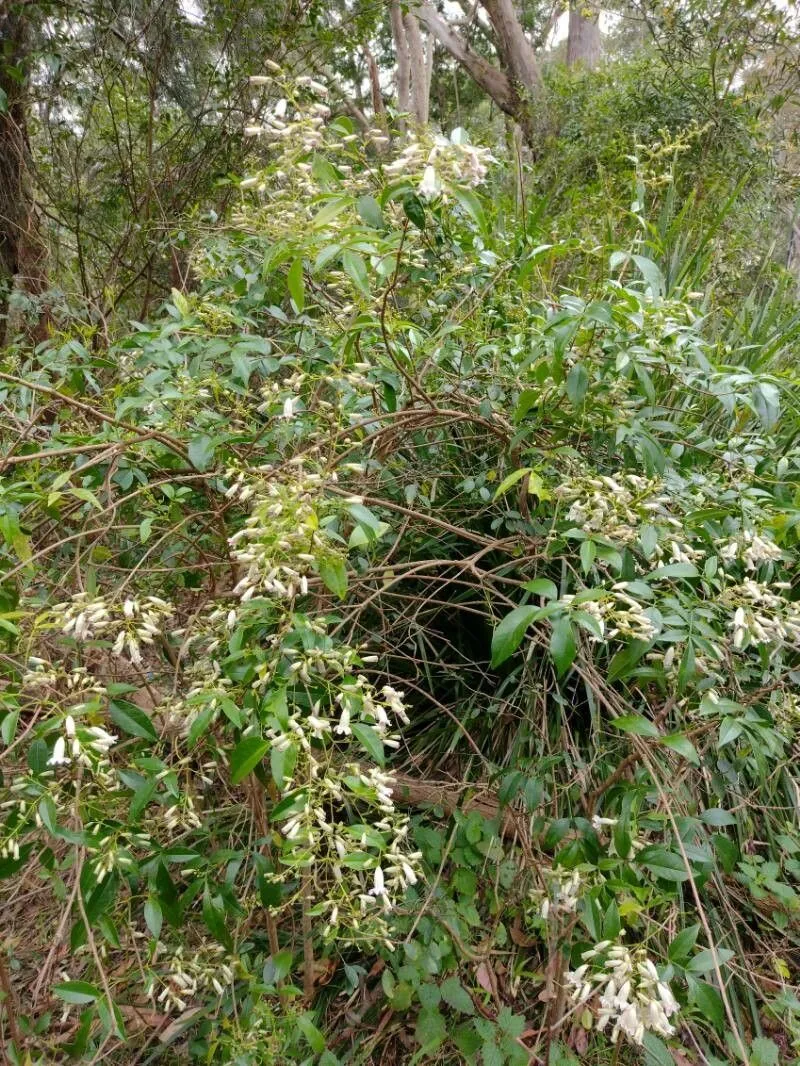
Author: (Andrews) Steenis
Bibliography: Bull. Jard. Bot. Buitenzorg, sér. 3, 10: 198 (1928)
Year: 1928
Status: accepted
Rank: species
Genus: Pandorea
Vegetable: False
Observations: Lesser Sunda Is. to New Caledonia and Australia
The Wonga-wonga-vine, scientifically known as Pandorea pandorana, is a captivating climber celebrated for its vibrant and striking appearance. This plant belongs to the Bignoniaceae family, a notable group of flowering plants known for their ornamental and ecological importance.
Pandorea pandorana is native to a diverse range of regions, spanning from the Lesser Sunda Islands to New Caledonia and extending to Australia. This extensive distribution highlights the plant’s adaptability to various climates and conditions, allowing it to thrive in both tropical and subtropical environments.
Characterized by its beautiful, trumpet-shaped blossoms, the Wonga-wonga-vine offers a stunning display of colors, typically ranging from creamy whites and yellows to rich pinks and reds. The flowers often grow in clusters, creating a lush and eye-catching spectacle that can transform any garden or landscape. These blooms are not just visually appealing but also attract a variety of pollinators, including bees and butterflies, contributing to the biodiversity of their habitat.
The leaves of Pandorea pandorana are another striking feature. They are usually glossy and pinnate, comprising several leaflets that add a textured green backdrop to the vibrant flowers. This foliage can provide a lush green cover, making the vine an excellent choice for creating natural screens or covering large structures such as trellises and pergolas.
The plant’s robust climbing ability is supported by its tendrils, which can latch onto various surfaces, allowing it to scale walls, fences, and other supports with ease. This makes the Wonga-wonga-vine a versatile plant for both decorative and functional gardening purposes.
First formally described in 1928, according to the Bulletin of the Buitenzorg Botanic Gardens (specifically in series 3, volume 10, page 198), the plant was classified by botanist Cornelis Gijsbert Gerrit Jan van Steenis. The Wonga-wonga-vine’s scientific notation reflects its classification by the well-respected botanist, identifying (Andrews) Steenis as the authoritative figure behind its nomenclature.
In summary, Pandorea pandorana, or the Wonga-wonga-vine, is a remarkable plant that adds aesthetic value and ecological benefits to its surroundings. Its stunning flowers, attractive foliage, and vigorous climbing nature make it a beloved choice among gardeners and plant enthusiasts across its native ranges and beyond.
Swe: pandorea
Eng: wonga-wonga-vine, wongavine
En: Wonga-wonga-vine, Wongavine, Spearwood bush, Wonga wonga vine, Western wonga vine
Sv: Pandorea
Taken Mar 9, 2022 by flo flo (cc-by-sa)
Taken Jun 8, 2020 by Jeremytuplin Jeremy Tuplin (cc-by-sa)
Taken Mar 10, 2022 by Arianna Mariani (cc-by-sa)
Taken Jul 6, 2021 by Sarah Hart (cc-by-sa)
Taken Aug 5, 2022 by Boris Therock (cc-by-sa)
Taken Sep 15, 2022 by merrisdiss (cc-by-sa)
Taken Sep 8, 2019 by Jian Chen (cc-by-sa)
Taken Aug 5, 2022 by Boris Therock (cc-by-sa)
Taken Oct 8, 2020 by Kim Monk (cc-by-sa)
Taken Aug 5, 2022 by Boris Therock (cc-by-sa)
© copyright of the Board of Trustees of the Royal Botanic Gardens, Kew.
© copyright of the Board of Trustees of the Royal Botanic Gardens, Kew.
© copyright of the Board of Trustees of the Royal Botanic Gardens, Kew.
Taken Jan 1, 1970 by Endemia – Daniel & Irène Létocart (cc-by-nc)
Taken Jan 1, 1970 by Endemia – Daniel & Irène Létocart (cc-by-nc)
Taken Aug 5, 2022 by Boris Therock (cc-by-sa)
Taken Aug 10, 2021 by ian connop (cc-by-sa)
Family: Myrtaceae Author: (F.Muell.) K.D.Hill & L.A.S.Johnson Bibliography: Telopea 6: 402 (1995) Year: 1995 Status:…
Family: Rubiaceae Author: Pierre ex A.Froehner Bibliography: Notizbl. Bot. Gart. Berlin-Dahlem 1: 237 (1897) Year:…
Family: Sapindaceae Author: Koidz. Bibliography: J. Coll. Sci. Imp. Univ. Tokyo 32(1): 38 (1911) Year:…
Family: Asteraceae Author: A.Gray Bibliography: Pacif. Railr. Rep.: 107 (1857) Year: 1857 Status: accepted Rank:…
Family: Fabaceae Author: Medik. Bibliography: Vorles. Churpfälz. Phys.-Ökon. Ges. 2: 398 (1787) Year: 1787 Status:…
Family: Aspleniaceae Author: (Cav.) Alston Bibliography: Bull. Misc. Inform. Kew 1932: 309 (1932) Year: 1932…